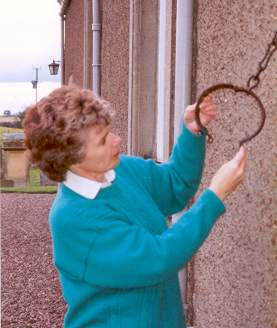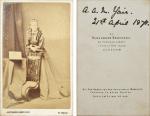The Church
There is no way of ascertaining what religious beliefs and rituals were observed by the earliest inhabitants of Eckford, but it is clear that they at least believed in a life after death. The Beakers, now preserved in Edinburgh, are normally found in graves. Eckford, early in its history, must have been in touch with Christianity. The site of the church on a knoll close to the old ford is a clue. There is a tradition that it originated from the traffic of the monks between the old ecclesiastical centres of Lindisfarne, or Holy Island, and St. Kentigern’s at Glasgow. Later it became a chapel attached to Jedburgh Abbey. The church on this site was repeatedly destroyed in Border raids, since Eckford seems to have been a community of considerable size and importance, being mentioned in the dispatches of the Earl of Surrey to Henry VIII, but the oldest part of the present building is believed to date from circa 1665. In one of the later raids, the bell from Eckford Church is reputed to have been removed and installed in Carham Church across the Border.
 An outstanding relic of the past is the jougs, or iron collar, an instrument of punishment used by the Kirk session. The penitent installed there had to wear a robe of sackcloth and thereafter sit on the penitent’s stool in front of the congregation.
An outstanding relic of the past is the jougs, or iron collar, an instrument of punishment used by the Kirk session. The penitent installed there had to wear a robe of sackcloth and thereafter sit on the penitent’s stool in front of the congregation.

An interesting feature is the little round tower, known locally as the ‘ghoul’ tower, which was built as a precautionary measure against body snatchers. The old flintlock musket used by the watchers still stands in the church today. (In 1999 it is no longer there.)
There is a story that a Kelso man, one James Goodfellow, was walking home late after courting a girl in Crailing, the day after a burial in Eckford and saw a dim light in the churchyard. Creeping nearer, he found a pony and cart secreted in the glebe (church field) and giving the pony a hearty skelp (slap), sent it galloping off. The miscreants immediately left their grisly task and rushed after it. This gave James Goodfellow a chance to get into the graveyard, where he found an open coffin. He just had time to hide the body behind a nearby gravestone and install himself in the coffin, covering himself with the pall. The returning body snatchers lifted the coffin on to the cart and drove towards Kelso, but a mile or so out of the town one of them leaned against the ‘body’ and exclaimed “Jock, this body’s warm!” The chance was too good to be missed and the ‘body’ sat up and said, “If you had been where I have been, you would be warm too!” This was the last straw for the nerve-ridden thieves who leapt down and fled. The ‘body’ then drove the pony and cart to Kelso and though enquiries were made, the owners never claimed them and a flourishing little business for the finder had its first assets.
Inside the church is a ‘laird’s loft’ and behind it is a retiring room. In front of the laird’s loft hangs a hatchment (tablet of deceased person’s armorial bearings) of a member of the Bennet family, at one time of Marlefield and a heritor of the church.
The manse lies to the west of the church across the glebe (church field) and was built about 1750, just five years too late to see Bonnie Prince Charlie and his followers pass on their way from Sunlaws, where they had spent the night, to Jedburgh. Originally a three storey building, it was altered in 1808 and is now two storeys but with additions at either end. The original walls were three feet thick and some of the additional rooms are approached by passages and archways through the thickness of these walls. The manse too has its link with the resurrectionists, for the brother of one of the Ministers was a medical student in Edinburgh. He was suspected of being involved in receiving bodies and was hidden for three months in a dark closet, taking exercise only after dark. Later he went to Berwick and from there to the Continent.
According to ‘Berwick and the Borders, an Illustrated Architectural Guide’, the church was built in 1771. It goes on to say, ‘Fragments of 1668 and aisle (Burial vault, laird’s loft over) of 1724. Alterations 1848 and porch added. Jougs (from 1718) mort bell and 19th century castellated red sandstone watch-house. Many fine 17th century gravestones.’
A book of monumental inscriptions of Eckford is published by the Borders Family History Society (Roxburghshire Monumental Inscriptions V (2nd Edition) ISBN 1 874232 09 5). It records all the stones in the graveyard which are legible and includes a complete transcription of the Hearth Tax pertaining to Eckford Parish. This provides a useful list of names which could be found in the parish at the end of the seventeenth century. The webmaster has a copy and would be pleased to provide relevant information to anyone doing family history research related to the area.
